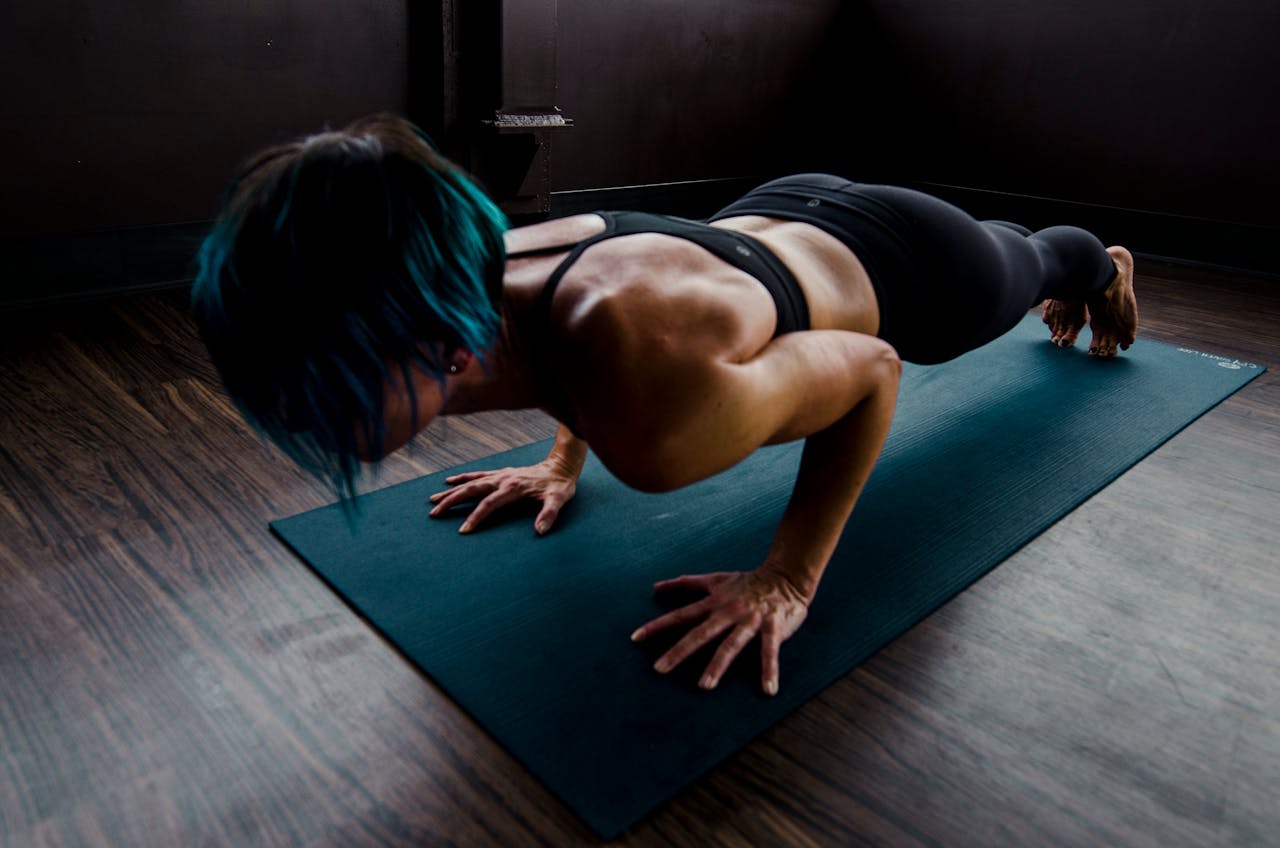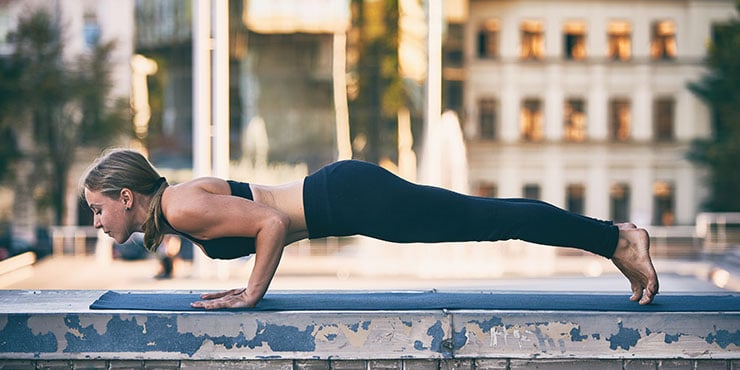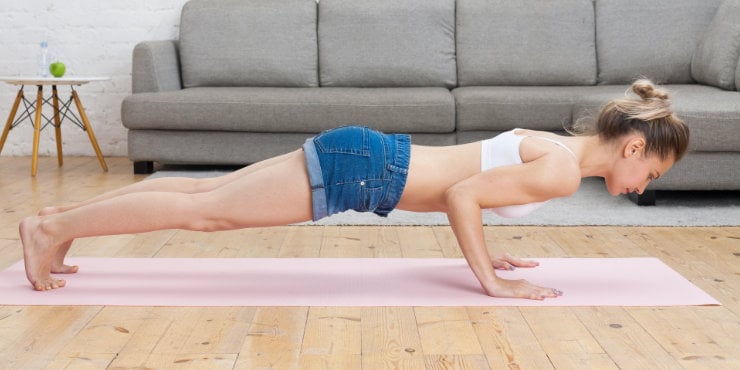
Table of Contents
Chaturanga Dandasana, or Four-Limbed Staff Pose, is a foundational yoga pose often used as a transition between Plank Pose and Upward-Facing Dog Pose. It is one of the most challenging and common postures that build strength in the arms, shoulders, and core while engaging the whole body.
Chaturanga Dandasana - The Four-Limbed Staff Pose
Chaturanga Dandasana, or Four-Limbed Staff Pose, is a variation of Plank Pose with elbows bent. It resembles the bottom part of a push-up but with the body suspended above the ground on hands and feet.
In yoga practice, Chaturanga Dandasana appears ubiquitously in Ashtanga Yoga, Power Yoga, and Sun Salutations. It is also common during vinyasa between seated postures, followed by Upward Facing Dog and Downward Facing Dog.
Health Benefits
Chaturanga Dandasana, also known as the Four-Limbed Staff Pose, is a challenging yoga pose that offers a variety of health benefits. Some of the benefits of practicing Chaturanga Dandasana include:
- Builds upper body strength: Chaturanga strengthens the shoulders, arms, chest, and back muscles.
- Improves posture: Regular Chaturanga Dandasana practice helps improve posture by improving the back, shoulders, and core strength muscles.
- Increases flexibility: Chaturanga Dandasana also helps to increase flexibility in the wrists, arms, shoulders, and chest.
- Improves bone health: This pose is a weight-bearing exercise, which can help improve bone health and prevent osteoporosis.
- Reduces stress and anxiety: Practicing Chaturanga Dandasana can help to reduce stress and anxiety by promoting relaxation and a sense of calm.
Chaturanga Dandasana associates with the Manipura (solar plexus) chakra, the seat of personal power, will, and self-confidence. The pose is said to help stimulate and balance this chakra, promoting greater self-awareness and self-esteem.
Contraindictions of Chaturanga Dandasana
Chaturanga Dandasana can be contraindicated or challenging for individuals with certain conditions or injuries, such as:
- Wrist injuries: Chaturanga's weight-bearing load on the hands and wrists can exacerbate wrist pain, particularly if the wrists go beyond their capacity.
- Shoulder injuries: Chaturanga requires a significant amount of strength and stability in the shoulders, and individuals with a shoulder injury may find the pose challenging or even exacerbating.
- Elbow injuries: The repetitive bending and straightening of the elbow joint in Chaturanga can be challenging for individuals with elbow injuries or conditions like tennis elbow.
- Carpal Tunnel Syndrome: As mentioned earlier, the ninety-degree wrist bend in Chaturanga can be challenging for individuals with carpal tunnel syndrome, and modifications may be necessary.
- Pregnancy: Pregnant women may need to modify Chaturanga or avoid it altogether, especially in the later stages of pregnancy, to avoid putting excess pressure on the abdominal muscles and to avoid lying on the stomach.
As always, yoga practitioners should consult with a qualified yoga teacher or healthcare professional if they have any concerns or conditions that may affect one's ability to practice Chaturanga Dandasana safely.
How to do Chaturanga Dandasana
 Simply put, here are the five steps to performing the Chaturanga Dandasana pose as one of the ashtanga yoga poses:
Simply put, here are the five steps to performing the Chaturanga Dandasana pose as one of the ashtanga yoga poses:
1. Begin in a plank position with your shoulders over your wrists and your body in a straight line.
2. Lower your body down as you bend your elbows, keeping your elbows close to your ribcage.
3. Stop when your elbows are at a 90-degree angle, and the shoulders align with the elbows.
4. Hold the pose for a few breaths, engaging your core and leg muscles to keep your body in a straight line.
5. Lower the body to the ground and come into a cobra or upward-facing dog pose to release the pose.
While this is a very challenging pose, Chaturanga is a highly challenging pose that requires preparation. Please continue reading to learn more about how practitioners can prepare their bodies for the complexities of Chaturanga.
Blocked Arms Chaturanga Dandasana
This chaturanga variation helps to support the weight of the shoulders so that you can find the positioning of the shoulder joints in this pose. Place two blocks vertically at the top of the mat, slightly narrower than shoulder-width apart. Come into Plank Pose with the hands just behind the blocks. Shift the weight slightly forward, then bend the elbows straight behind you to slowly lower the shoulders onto the ground.
The Importance of Full Body Activation in Chaturanga
Chaturanga Dandasana requires strong arms and shoulders and the ability to use both muscles to support the wrists, elbows, and shoulders. Activating the torso, hips, knees, and feet also contributes to maintaining the body weight in a straight line.
The idea behind yoga poses is to use the entire body - with Chaturanga Dandasana, this means using muscular effort to feel and control all parts in a way that they work together. This will make it easier to hold the pose while feeling effortful yet effortless at the same time.
Strengthening Poses for the Upper Arms
The Low Lunge pose allows practitioners to refine their bent arm position for Chaturanga Dandasana. Instead of relying on forearms for support as they deepen into the pose, they can activate their arms like Four-Limbed Staff Pose to bring their torso closer to the ground. As the posture draws strength from the front leg, practitioners can also focus on each arm individually, preparing the body for arm balances.
Integrating the Upper Body with Resisted Pushing
Resisted pushing is a low-tech method to strengthen the required muscles while lying on the belly. Pushing down into the floor and resisting the urge to lift the body help the muscles integrate effectively. This technique can benefit individuals seeking to strengthen their muscles without using any equipment.
Pressing with the hands
When lying on the belly, individuals can engage their abdominal muscles and other muscles to connect the ribcage and pelvis by pressing down firmly with both hands beside the ribcage keeping the elbows close to the body. By putting maximum effort into the pressing without allowing the body to lift and gradually releasing the pressure, the ribcage gains enough weight to resist pushing up. Increasing the pushing force further can activate leg muscles, resulting in greater resistance.
Pressing with the feet
One can attempt to lift their body off the floor by pressing their forefeet firmly into the ground, with their toes tucked under and knees straight. By resisting the urge for the pelvis to lift and pressing down on the feet with maximum pressure before using the hands, individuals can feel their legs and arms and have a sturdy torso activation. As they press down with their feet, they can try to lift their body off the floor.
Gradually Lifting
Apply pressure to the feet and hands, and resist until the body becomes light on the floor so that the ribcage, belly, and thighs lightly touch the ground. From there, allow the body to lift by supporting its weight while changing the bend in elbows and shoulders. Minimal extra effort should be needed if one can feel when the body only lightly touches the floor.
Controlling Initial Elbow Bend
The transition from plank to Chaturanga can be challenging due to the change in upper arm rotation. To become familiar with this action, try slightly bending the elbows while on all fours and gradually rotating the arms. To add resistance, push down and protract while maintaining tension in the arms. When transitioning to plank, push down and protract before stepping back and bending the elbows. To lower from Plank to Chaturanga, push the hands forward while resisting with the feet, and ensure that the shoulders don't go lower than the elbows to protect the rotator cuff.
Another Take on Resisted Pushing
A resisted push technique can caterpillar the body backward or move it forward. By pushing their hands downwards and resisting their body from moving upwards, individuals can press their hands against the floor to help their bodies move back. Practicing this movement a few times while activating and relaxing can help individuals understand the technique. Similarly, individuals can move their bodies forward by pushing their feet down and back against the floor. Using a resisted push can make it easier to lift the body by pushing the hands down and pressing the floor forward while resisting movement with the feet.
Practicing Safe Alignment in Chaturanga Dandasana
 To do Chaturanga correctly, one must keep the deep core engaged, focus on stabilizing the shoulders and ensure a 90-degree angle (or right angle) at the elbow. It is essential to maintain a straight body and avoid letting the shoulders dip down by lengthening the crown of the head forward toward the top of the yoga mat. Additional control exercises one may want to use to develop strength include:
To do Chaturanga correctly, one must keep the deep core engaged, focus on stabilizing the shoulders and ensure a 90-degree angle (or right angle) at the elbow. It is essential to maintain a straight body and avoid letting the shoulders dip down by lengthening the crown of the head forward toward the top of the yoga mat. Additional control exercises one may want to use to develop strength include:
Practicing Scapular Control
Scapula is the anatomical name for the shoulder blade. The scapulae attach to the clavicles (collar bones), which connect to the top of the sternum (breast bone), forming the shoulder girdle. The shoulder socket is on the outer edge of the shoulder blade, just below where it connects to the collarbone.
Practicing Protraction
When standing upright, moving one's shoulders forward results in protraction, causing the scapulae to move away from the spine. Individuals may feel spreading or light stretching between their shoulders by performing this movement slowly while standing or sitting upright, with arms by the sides and relaxed shoulders and upper chest.
Practicing Retraction
Moving the shoulders back is called retraction and can activate the muscles between the shoulder blades. Protraction lifts the upper body away from the floor, while retraction brings it closer to the floor. To move from all fours to a high plank, start in a protracted position with the chest lifted, then push the hands forward while resisting the body moving back.
Adjusting protraction and retraction
A good idea is to practice both retraction and protraction while in a high or low plank, or even moving between the two while holding the plank position.
- Try it in cat pose (Marjariasana) first.
- Then try it for two to three repetitions before resting, focusing on moving slowly and smoothly.
- Then work at gradually extending the number of repetitions.
To achieve greater comfort or better support while performing protraction or retraction movements, one may adjust their shoulder blades forward towards their head or rearwards away from their head.
Practicing Rotational Control
These exercises aim to improve scapular and upper arm control. Rotating the upper arms slowly while sitting or standing can increase awareness and familiarity with the shoulder joints and scapulae. Similarly, individuals can practice while keeping their shoulder blades retracted or protracted. To improve alignment, individuals can adjust the rotation of their upper arms so that the elbows point back instead of outward when bending during protraction.
Practicing Forearm and Elbow Stabilization
It is essential to consider the forearms and elbows in Chaturanga. Rather than solely focusing on stabilizing the shoulders, it is also necessary to work on thoracic control to provide a stable anchor for the scapular stabilizing and controlling muscles. Stabilizing from the hands up is also possible by activating the arms. To activate the forearms, press down with the fingertips. Another option is to press the fingertips into the floor with the fingers spread.
Chaturanga Dandasana Arm Position
It is essential to position the arms parallel to each other and vertically align the forearms so that the elbows are bent ninety degrees. This can strain the wrists, so practitioners can move their hands slightly forward to reduce the wrist bend.
Focus on the stability and control of the ribcage, shoulder girdle, shoulder joints, elbow joints, and wrists to avoid injury. Practitioners can gradually become more aware of their bodies and adjust how they use their arms during Chaturanga by practicing different forearm positioning options and getting stronger in all of them. Exercises like pointing the elbows back can also help maintain proper alignment.
From all Fours to Plank Pose
To use friction while starting from a Plank position, individuals can begin by getting a feel for the movement. Plank is similar to the top position of a traditional push-up, with the elbows straight. Individuals can start on all fours to practice pushing the hands forward while preventing the body from moving back.
By pressing the hands forwards and resisting the body from moving back with their knees or feet, individuals can get accustomed to the movement. They can then maintain tension in their hands and feet while stepping back into the plank pose. Before lowering, practicing some scapular control may be helpful.
References
Chaturanga Dandasana - Wikipedia
What is Utthita Chaturanga Dandasana? - Definition from Yogapedia
Disclaimer
The contents of this article are provided for informational purposes only and are not intended to substitute for professional medical advice, diagnosis, or treatment. It is always recommended to consult with a qualified healthcare provider before making any health-related changes or if you have any questions or concerns about your health. Anahana is not liable for any errors, omissions, or consequences that may occur from using the information provided.

By: Anahana
The Anahana team of researchers, writers, topic experts, and computer scientists come together worldwide to create educational and practical wellbeing articles, courses, and technology. Experienced professionals in mental and physical health, meditation, yoga, pilates, and many other fields collaborate to make complex topics easy to understand. Anahana is also home to specialists in crystals, tarot, angel numbers, astrology, life path numbers, zodiac signs, and horoscopes. By combining evidence-based wellness with spiritual and energetic practices, the team offers clear, trustworthy guidance for both mind-body health and modern spirituality.